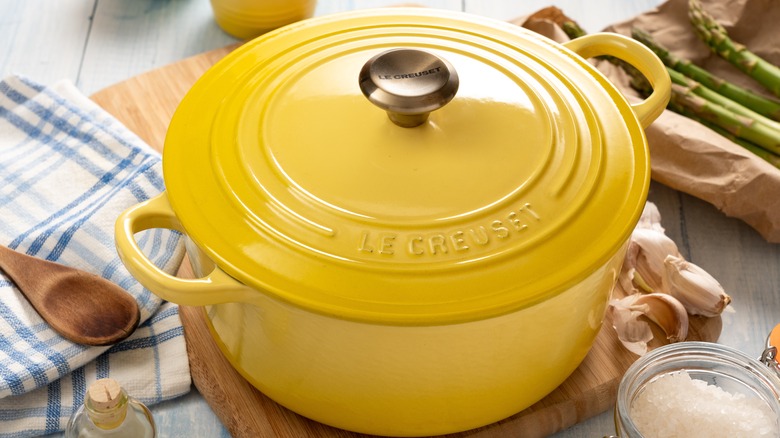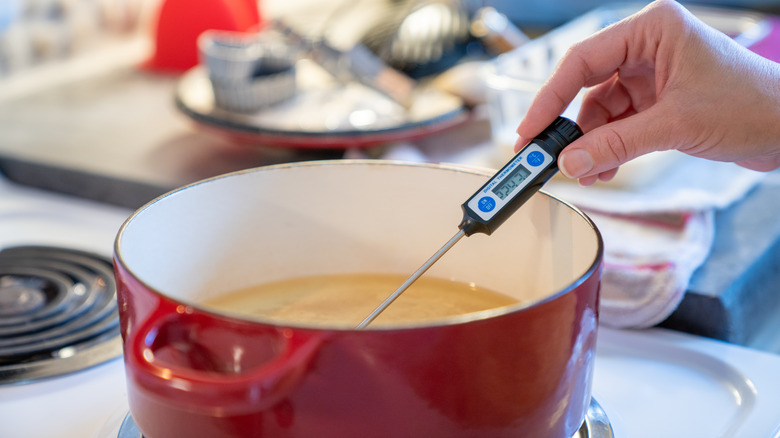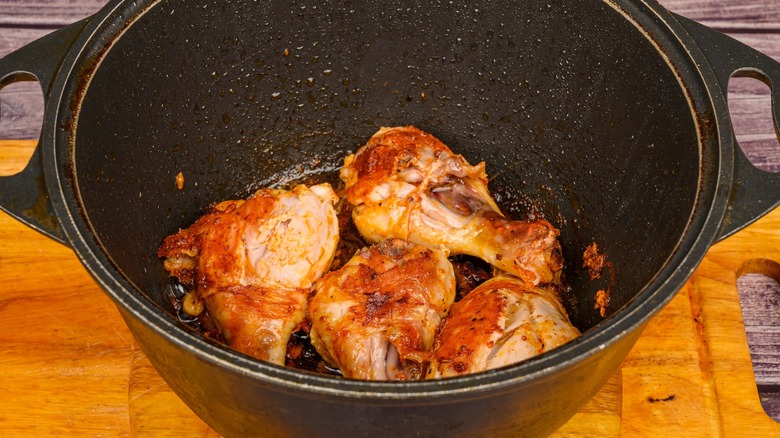Here's Why Dutch Ovens Are Always Recommended For Frying
Frying is a surefire way to make crispy, juicy meat and is the perfect quick cooking method for making veggies and desserts flavorful. However, a lot of cooks are afraid of frying at home because splattering oil can create a mess on cooking surfaces and increase the risk of grease fires. There's a foolproof way to avoid these concerns, though: the Dutch oven.
A Dutch oven is a heavy-bottom pot with thick, tall walls, and it can be used for all manner of cooking techniques — from boiling and slow cooking to sauteing, searing, and baking. This design makes it ideal for deep frying because you can fill your pot with oil and fully submerge foods without the oil splashing onto your stove's surface (or you). Its size also means you can fry large foods, such as chicken legs, better than using a shallow pan, like a wok.
On top of that (pun intended), the lid of a Dutch oven fits securely around the rim. While this is important for keeping steam inside the pot while slow cooking and baking, it's also very handy in case of a grease fire. Carefully putting the lid over the flames will deprive them of oxygen and quickly smother them out.
Safety isn't the only benefit of frying in a Dutch oven
While the safety of using a Dutch oven for frying is an excellent advantage, it's not the main reason you want to fry with this kitchen tool. Most often made of enameled cast iron, Dutch ovens have impeccable heat retention and distribution, which is why it's Alton Brown's favorite way to fry burgers.
For deep frying, you typically need to keep the oil between 300 to 325 degrees Fahrenheit. If the heat level drops too much, the food will come out soggy rather than crispy. On the other hand, the food will burn on the outside but not cook all the way through when the temperature is overly hot. A Dutch oven is designed to maintain the heat level and distribute it evenly so your food comes out perfectly. It even keeps the oil temperature pretty consistent when you add pieces of food so you don't have to adjust your burner setting as you fry.
Other advantages are that the light interior color of an enameled Dutch oven makes it easy to see color changes when frying to ensure a golden brown crust and that its nonstick nature makes for easy clean-up afterward — no matter what you make. Alternatively, there's a benefit if you're using a new non-enameled, cast iron Dutch oven: Frying is an ideal way to season the cookware quickly, creating a shiny, nonstick coating over time and enhancing your food's flavor.
Tips for using a Dutch oven for deep frying
Since deep frying in a Dutch oven is a fast process, you want to be prepared before you start. Have a deep fat thermometer ready to test when the oil is heated and to monitor the temperature, and set aside a rack or sheet pan lined with towels to place fried foods on so that excess oil can drain off.
Also, ensure you have the right kind of oil because using the wrong oil is one of the biggest mistakes to avoid when deep frying. Grapeseed, peanut, and canola oils are excellent options because they have a high smoke point. You want to use just enough to fully submerge the food that you're deep frying — not so much that it reaches more than halfway up the sides of your Dutch oven.
When the oil is hot enough, you can use a skimmer or tongs to gently place your food inside. Be careful not to put a lot of food in at once because it will lower the temperature too much. Frying in batches is preferred, and you can easily test the oil with your thermometer between batches, increasing the temperature if necessary. Then, you can use a skimmer or tongs to remove the food, being careful not to disturb the crunchy results as you place it onto the waiting rack or sheet pan. And, after cooling, you can strain and reuse the leftover frying oil.


